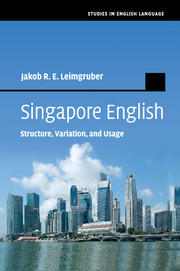Book contents
- Frontmatter
- Dedication
- Contents
- List of figures
- List of tables
- Acknowledgements
- List of abbreviations, glosses, and symbols
- 1 Introduction: Singapore and its Englishes
- 2 Variation in Singapore English: old and new models
- 3 Description: phonology and lexicon
- 4 Description: grammar
- 5 Indexicality: a model for Singapore?
- 6 Conclusion: the variety as a structural unit
- Appendix A Chinese romanisation
- Appendix B Informants
- Appendix C Chinese languages
- References
- Author index
- Subject index
3 - Description: phonology and lexicon
Published online by Cambridge University Press: 05 July 2013
- Frontmatter
- Dedication
- Contents
- List of figures
- List of tables
- Acknowledgements
- List of abbreviations, glosses, and symbols
- 1 Introduction: Singapore and its Englishes
- 2 Variation in Singapore English: old and new models
- 3 Description: phonology and lexicon
- 4 Description: grammar
- 5 Indexicality: a model for Singapore?
- 6 Conclusion: the variety as a structural unit
- Appendix A Chinese romanisation
- Appendix B Informants
- Appendix C Chinese languages
- References
- Author index
- Subject index
Summary
When describing a variety such as Singapore English, the first question that arises is: which Singapore English? The Singlish used by the lesser-educated hawker is quite unlike the polished Standard English employed by a minister when addressing parliament, and not just in the choice of vocabulary: pronunciation and grammar differ, too. And yet both have to be considered instantiations of Singapore English, as they are, obviously, English, and used by Singaporeans. This variability is omnipresent, as I hope to make explicit in the following description.
Phonology
Vowels
The monophthongs of SgE are generally given as in Table 3.1 (see e.g. Bao 1998 or Deterding 2007a). This inventory shows the absence of phonemic length distinction (i.e. beat and bit are pronounced identically); this absence seems generalised in the speech community. There is, however, conditioning by phonological environment: vowels are ‘relatively short, except in open syllables’ (Bao 1998: 156). Thus beat and bit are both /bit/, but bee, being /bi/, is realised as [biː].
SgE has five diphthongs (face and goat are monophthongised to /e/ and /o/ respectively) which are phonologically identical to RP's, but phonetically much narrower, the two centring diphthongs particularly so. Deterding (2007a: 26-7)mentions that the diphthong /uə/ distributes differently in SgE from how it does in RP. In the words poor, tour, and sure the vowel is usually a diphthong [uə], whereas in pure and cure it tends to be [jɔ]. This, Deterding notes, is ‘the inverse of the common pattern in modern RP’ (2007a: 26).
- Type
- Chapter
- Information
- Singapore EnglishStructure, Variation, and Usage, pp. 64 - 70Publisher: Cambridge University PressPrint publication year: 2013



